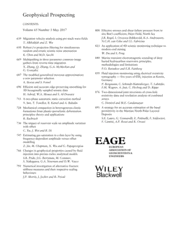
Full text loading...
In this study, a new two‐dimensional inversion algorithm was developed for the inversion of cross‐hole direct current resistivity measurements. In the last decades, various array optimisation methods were suggested for resistivity tomography. However, researchers have still collected data by using classical electrode arrays in most cross‐hole applications. Therefore, we investigated the accuracy of both the individual and the joint inversion of the classical cross‐hole arrays by using both synthetic and field data with the developed algorithm. We showed that the joint inversion of bipole–bipole, pole–bipole, bipole–pole, and pole–tripole electrode arrays gives inverse solutions that are closer to the real model than the individual inversions of the electrode array datasets for the synthetic data inversion. The model resolution matrix of the suggested arrays was used to analyse the inversion results. This model resolution analysis also showed the advantage of the joint inversion of bipole–bipole, pole–bipole, bipole–pole, and pole–tripole arrays. We also used sensitivity sections from each of the arrays and their superpositions to explain why joint inversion gives better resolution than the any individual inversion result.

Article metrics loading...

Full text loading...
References


Data & Media loading...

